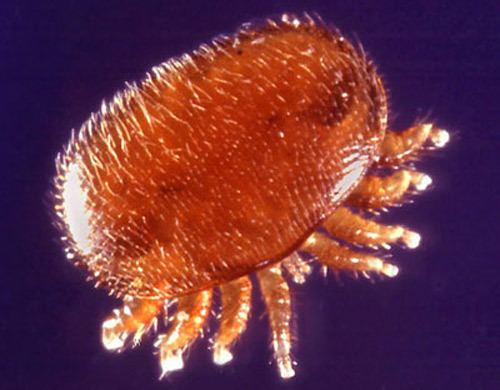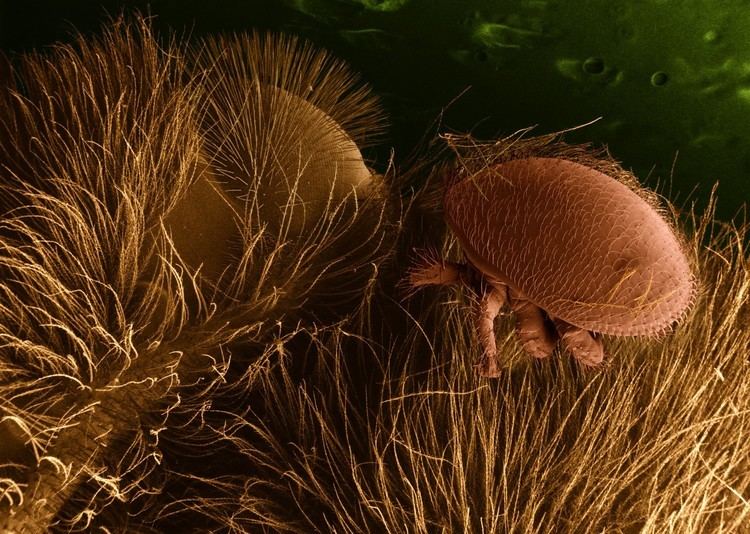Family Varroidae Scientific name Varroa destructor Subclass Acari Rank Species | Genus Varroa Higher classification Varroa Order Parasitiformes | |
 | ||
Similar Western honey bee, Honey bee, Nosema apis, Bee, Small hive beetle | ||
Varroa destructor 3 min
Varroa destructor (Varroa mite) is an external parasitic mite that attacks the honey bees Apis cerana and Apis mellifera. The disease caused by the mites is called varroosis.
Contents
- Varroa destructor 3 min
- Varroa destructor
- Physical description
- Reproduction infection and hive mortality
- Introduction around the world
- Identification
- Varroosis
- Chemical measures
- Physical mechanical behavioral methods
- Genetic engineering
- References
The Varroa mite can only reproduce in a honey bee colony. It attaches to the body of the bee and weakens the bee by sucking hemolymph. In this process, RNA viruses such as the deformed wing virus (DWV) spread to bees. A significant mite infestation will lead to the death of a honey bee colony, usually in the late autumn through early spring. The Varroa mite is the parasite with the most pronounced economic impact on the beekeeping industry. It may be a contributing factor to colony collapse disorder, as research shows it is the main factor for collapsed colonies in Ontario, Canada and the United States.

Varroa destructor
Physical description
The adult female mite is reddish-brown in color, while the male is white. Varroa mites are flat, having a button shape; are 1–1.8 mm long and 1.5–2 mm wide; and have eight legs.
Reproduction, infection and hive mortality

Mites reproduce on a 10-day cycle. The female mite enters a honey bee brood cell. As soon as the cell is capped, the Varroa mite lays eggs on the larva. The young mites, typically several females and one male, hatch in about the same time as the young bee develops and leave the cell with the host. When the young bee emerges from the cell after pupation, the Varroa mites also leave and spread to other bees and larvae. The mite preferentially infests drone cells, allowing the mite to reproduce one more time with the extra three days it takes a drone to emerge vs a worker bee. This can cause genetic defects such as useless wings or viruses and fungi in the bee.
The adults suck the "blood" (hemolymph) of adult honey bees for sustenance, leaving open wounds and transmitting diseases and viruses. The compromised adult bees are more prone to infections. With the exception of some resistance in the Russian strains and bees that have Varroa sensitive hygiene (about 10% of colonies naturally have it), the European Apis mellifera bees are almost completely defenseless against these parasites (Russian honey bees are one-third to one-half less susceptible to mite reproduction).
The model for the population dynamics is exponential growth when bee brood are available and exponential decline when no brood is available. In 12 weeks, the number of mites in a western honey bee hive can multiply by (roughly) 12. High mite populations in the autumn can cause a crisis when drone rearing ceases and the mites switch to worker larvae, causing a quick population crash and often hive death.
Varroa mites have been found on Tricia larvae of some wasp species, such as Vespula vulgaris, and flower-feeding insects such as the bumblebee, Bombus pennsylvanicus, the scarab beetle, Phanaeus vindex and the flower-fly, Palpada vinetorum. It parasitizes on the young larvae and feeds on the internal organs of the hosts. Although the Varroa mite cannot reproduce on these insects, its presence on them may be a means by which it spreads short distances (phoresy).
Introduction around the world
As of mid-2012, Australia is thought to be free of the mite. In early 2010, an isolated subspecies of bee was discovered in Kufra (southeastern Libya) that appears to be free of the mite. The Hawaiian islands of Maui, Kauai, Molokai, and Lanai are all free of the mite.
Identification
Until recently, V. destructor was thought to be a closely related mite species called Varroa jacobsoni. Both species parasitize the Asian honey bee, Apis cerana. However, the species originally described as V. jacobsoni by Anthonie Cornelis Oudemans in 1904 is not the same species that also attacks Apis mellifera. The jump to A. mellifera probably first took place in the Philippines in the early 1960s where imported A. mellifera came into close contact with infected A. cerana. Until 2000, scientists had not identified V. destructor as a separate species. This late identification in 2000 by Anderson and Trueman corrected some previous confusion and mislabeling in the scientific literature.
Varroosis
The infection and subsequent parasitic disease caused by Varroa mites is called varroosis. Sometimes, the incorrect names varroatosis or varroasis are used. A parasitic disease name must be formed from the taxonomic name of the parasite and the suffix -osis as provided in the Standardised Nomenclature by the World Association for the Advancement of Veterinary Parasitology. For example, the World Organisation for Animal Health (OIE) uses the name varroosis in the OIE Terrestrial Manual.
Treatments have met with limited success. First, the bees were medicated with fluvalinate, which had about 95% mite falls. However, the last 5% became resistant to it, and later, almost immune. Fluvalinate was followed by coumaphos.
Chemical measures
Varroa mites can be treated with commercially available miticides. Miticides must be applied carefully to minimize the contamination of honey that might be consumed by humans. Proper use of miticides also slows the development of resistance by the mites.
Synthetic chemicals
Naturally occurring chemicals
Physical, mechanical, behavioral methods
Varroa mites can also be controlled through nonchemical means. Most of these controls are intended to reduce the mite population to a manageable level, not to eliminate the mites completely.
Genetic engineering
Researchers have been able to use RNA interference to knock out genes in the Varroa mite. There have also been efforts to breed for changes in the honey bees. Two strains have been developed in the United States that can detect damaged pupae under cappings and remove them before the infestation spreads further. Another strain is under development that can more easily recognize adult phoretic Varroa so they can be groomed and removed from the hive.
